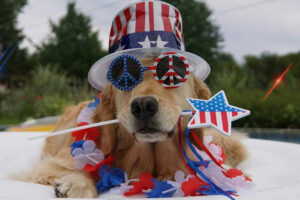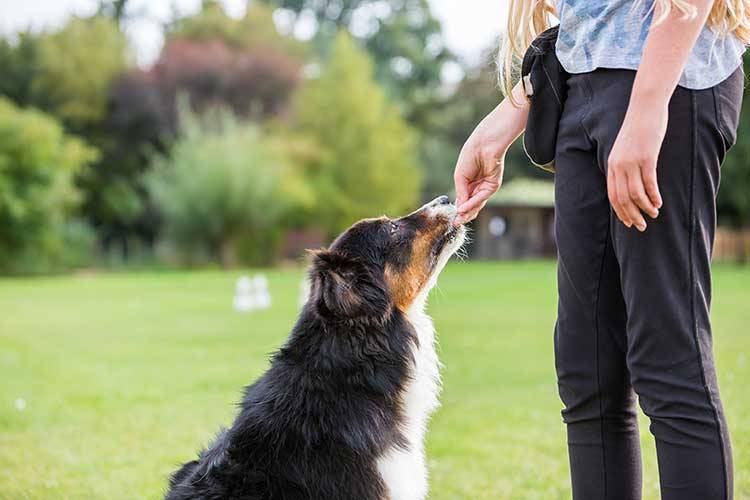Building Better Behavior Through Trust, Science, and Real-World Results
At Alaska Dog Works, we’ve trained thousands of dogs, from eager puppies to elite service dogs, and one thing remains constant: dogs learn best when they want to work with you, not when they’re afraid of what happens if they don’t.
That’s the essence of positive reinforcement training, a scientifically backed approach that builds trust, strengthens the bond between dog and owner, and delivers lasting results through motivation, not intimidation. Whether you’re working with a new puppy, a stubborn adolescent, or a specialized service dog, positive reinforcement lays the foundation for calm, confident, and reliable behavior.
What Is Positive Reinforcement Training?
Positive reinforcement is the process of rewarding a dog for behaviors you want to see more often. When your dog performs a desired action, like sitting, staying calm around distractions, or walking nicely on a leash, you reward that behavior with something meaningful: food, praise, toys, or access to play.
In short: Behavior that gets rewarded gets repeated.
This approach is rooted in the science of operant conditioning, a learning model first developed by B.F. Skinner. Rather than focusing on punishment for mistakes, it emphasizes clarity, consistency, and motivation.
At Alaska Dog Works, this philosophy forms the backbone of our programs, from obedience and behavior modification to our Lead Dog Service Dog Training and DAWGS Therapy Dog Program.
Why Positive Reinforcement Works
Dogs are problem-solvers. They repeat behaviors that lead to good outcomes and avoid those that lead to negative ones. Positive reinforcement capitalizes on that natural drive by helping dogs associate training with success.
Here’s why it’s so effective:
1. It Builds Trust, Not Fear
When dogs learn through positive methods, they develop confidence and security. They understand what’s expected and feel safe exploring new situations. Fear-based training, by contrast, often creates confusion, anxiety, or suppression, your dog might “comply” in the moment but won’t understand why.
A well-trained dog isn’t one that obeys because they’re scared; it’s one that obeys because they trust their handler.
2. It Strengthens the Human-Dog Bond
Positive reinforcement turns training into teamwork. When your dog realizes that listening to you leads to rewards and fun, they begin to view you as their trusted leader. That’s why we say at Alaska Dog Works: we don’t just train dogs, we build partnerships.
3. It Encourages Learning Through Motivation
Dogs that enjoy training learn faster. Positive reinforcement makes sessions engaging and productive, leading to long-term retention and reliability. When training feels like play, dogs stay focused, eager, and responsive.
4. It’s Effective Across All Ages and Breeds
From a high-energy Husky puppy to an older rescue or a working service dog, positive reinforcement is adaptable to every learning style. It’s especially powerful for dogs who are shy, sensitive, or recovering from trauma, because it replaces fear with confidence.
The Science Behind Reward-Based Training
Modern behavioral research overwhelmingly supports positive reinforcement as the most effective and humane method for training dogs. Studies from institutions like the American Veterinary Society of Animal Behavior (AVSAB) show that dogs trained with rewards show stronger obedience, lower stress levels, and fewer behavioral issues over time compared to those trained with punishment.
Here’s why:
Reward pathways in the brain release dopamine, the “feel-good” neurotransmitter, when a dog performs a behavior that earns a reward.
This chemical response strengthens the connection between the cue (“sit”) and the action, accelerating learning.
Over time, the positive emotional association becomes ingrained, leading to consistent, reliable behavior even without a treat every time.
At Alaska Dog Works, we use this science to create sustainable results that last well beyond the training session.
Common Myths About Positive Reinforcement
Even though positive reinforcement is proven to work, many misconceptions persist. Let’s clear them up.
Myth #1: “It’s just bribery.”
Bribery is when you show a treat before the behavior, like waving a cookie to get your dog’s attention. Reinforcement is different. It comes after your dog performs the desired behavior, reinforcing their choice to do it again. Over time, the treat fades, and praise or freedom becomes the reward.
Myth #2: “It doesn’t work on stubborn or dominant dogs.”
Every dog is motivated by something, it’s simply a matter of discovering what that is. Some respond to food, others to toys, and some to affection or play. At Alaska Dog Works, our trainers use a variety of reinforcers to find what drives each individual dog, from the softest therapy companion to the toughest working breed.
Myth #3: “You’ll always have to carry treats.”
Not true. Treats are tools, not crutches. As your dog learns, we gradually replace food with praise, toys, or environmental rewards like sniffing or freedom to explore. The end goal is reliability, not dependency.
How We Use Positive Reinforcement at Alaska Dog Works
Every training program at Alaska Dog Works, whether in-home, in-studio, or on the trail, is designed around a relationship-first philosophy. We focus on teaching both ends of the leash, ensuring that owners understand how to communicate clearly, fairly, and consistently.
1. Clear Communication
We start by teaching your dog what each command means through repetition and reward. Once your dog understands, we gradually add distractions, duration, and distance to make the behavior reliable in any environment.
2. Consistency and Timing
In positive reinforcement, timing is everything. A reward must immediately follow the desired behavior so your dog connects the dots. Our trainers use markers, such as “Yes!” or clickers, to signal success at exactly the right moment.
3. Proofing in Real-World Settings
Our training goes beyond the classroom. Whether it’s practicing calm greetings in downtown Anchorage, recall drills on local trails, or neutral behavior around other dogs, we make sure your dog’s new skills hold up where they matter most, out in the world.
4. Empowering the Handler
We don’t just train your dog; we train you to be a confident leader. When you understand how to apply positive reinforcement effectively, you’ll see faster progress and a happier, more connected partnership.
The Benefits of Positive Reinforcement Training
The results speak for themselves. Here’s what positive reinforcement delivers for both dogs and owners:
1. A More Confident Dog
Dogs that are rewarded for correct behavior become self-assured learners. They’re less reactive, less anxious, and more adaptable to new experiences, whether that’s traveling, visiting the vet, or meeting new people.
2. A Stronger Relationship
Because the process is built on mutual respect, you’ll see your dog looking to you for guidance instead of acting independently. That bond creates the foundation for all advanced training.
3. Better Behavior That Lasts
Dogs trained with punishment often suppress behavior out of fear, but when fear fades, the behavior returns. Reward-based training creates understanding, which leads to lasting change.
4. Safer and More Enjoyable Public Experiences
Whether you’re working toward therapy dog certification or simply want to enjoy walks without pulling or barking, positive reinforcement produces calm, focused, and socially appropriate dogs.
5. A Kinder, More Ethical Approach
As dog lovers, we have a responsibility to train with compassion. Positive reinforcement aligns with modern animal welfare standards and supports the emotional well-being of every dog we work with.
Real-World Success: From Barking to Balance
One of our Anchorage clients came to Alaska Dog Works with a young Labrador named Cooper. He barked at every dog he saw on the Coastal Trail and dragged his owner down the street. Through positive reinforcement, we taught Cooper to focus on his handler, rewarding calm behavior and eye contact.
Within weeks, Cooper’s barking decreased dramatically. By the end of his Peak Performance Program, he could walk past other dogs quietly and confidently, a transformation built on trust, not correction.
That’s the kind of partnership we help build every day.
Why Positive Reinforcement Matters for Service and Therapy Dogs
In our Lead Dog Service Dog Training Program, positive reinforcement isn’t just preferred, it’s essential. Service dogs must perform complex tasks reliably and maintain composure in high-stress public settings. The only way to achieve that level of focus and confidence is through trust-based training.
Similarly, our DAWGS Therapy Dog Program relies on positive reinforcement to ensure therapy dogs remain calm, gentle, and emotionally balanced while working in hospitals, schools, and counseling offices. Fear-based methods would erode that balance instantly.
Positive reinforcement doesn’t just teach obedience, it builds the emotional resilience dogs need to serve with grace and reliability.
Tips for Using Positive Reinforcement at Home
You don’t need to be a professional trainer to start using positive reinforcement. Here’s how to bring it into your daily routine:
Reward the Good – Catch your dog doing something right, sitting quietly, waiting patiently, walking beside you, and reward it.
Be Consistent – Everyone in the household should use the same cues and reward behaviors the same way.
Keep Sessions Short and Fun – Dogs learn best in 5–10 minute bursts. End each session on a positive note.
Vary the Rewards – Use treats, toys, praise, or play depending on what your dog values most.
Stay Patient – Learning takes time. Celebrate small wins along the way.
When to Seek Professional Guidance
If your dog’s challenges go beyond basic obedience, like aggression, anxiety, or reactivity, it’s best to work with a certified professional. At Alaska Dog Works, we combine positive reinforcement with decades of behavioral expertise to customize training plans for every personality and household.
Our trainers specialize in working dogs, therapy dogs, and family pets alike, always prioritizing communication, structure, and compassion.
The Takeaway: Train the Dog in Front of You
Positive reinforcement isn’t just a technique, it’s a mindset. It’s about seeing your dog as a thinking, feeling partner and teaching through respect instead of reaction.
When you approach training with patience and empathy, you don’t just change behavior, you strengthen the bond that makes dog ownership one of life’s greatest joys.
At Alaska Dog Works, that’s what we do every day: build better dogs by building better relationships.
Call to Action
If you’re ready to experience the power of positive reinforcement for yourself, schedule a strategy call with the professional trainers at Alaska Dog Works today. Whether you’re starting from scratch or fine-tuning advanced obedience, we’ll design a plan that fits your goals and your dog’s unique personality.
👉 Call 206-752-DOGS or visit AlaskaDogWorks.com to schedule your strategy call today.
We offer a FREE Strategy Call.
Click on the graphic to learn more
Read More

More Pets Go Missing July 4 & 5 Than Any Other Day. Be Prepared!









